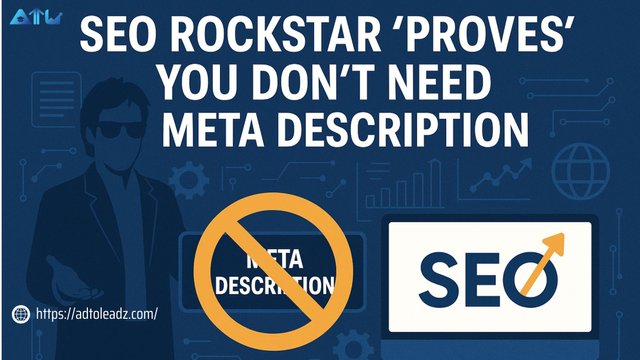SEO Rockstar “Proves” You Don’t Need Meta Descriptions
Nowadays,the Meta descriptions have long taken a kind of sacred place in SEO to-do lists, those summaries of a page that are just 150 or so characters long but are thought to affect clicks and improve search results. However, with the advance of algorithms that evolve quicker than their human counterparts, one disruptive strategist has taken control of the situation by turning the tables.
A disruptor in the industry, who is commonly referred to as SEO Rockstar, has dispelled the age-old practice of depending on meta descriptions. What he provides is not anecdotal evidence. It has its basis in scientific decoding of a more dogmatic practice in SEO.Here AdtoLeadz Technologies is the top-most and best SEO Agency in Madurai and we also curated some articles like this to increase our brand visibility and wanna increase web traffic.Before this just read the full article.Lets dive into…
Understanding the Conventional Wisdom
The standard SEO doctrine places meta descriptions as a bridge between SERP and user engagement. They serve as a sales pitch. A micro-advertisement designed to lure the click.
While they have never directly impacted rankings—Google has confirmed as much—their perceived role in boosting CTR has been enough to justify their meticulous curation. Copywriters agonize over every character, attempting to strike a balance between keyword inclusion and emotional resonance.
But much of this has become ritualistic. A rote exercise carried over from a time when algorithms were rudimentary, and human input was paramount.
Today, that orthodoxy is eroding.
The Experiment That Turned Heads
Rather than theorizing, the SEO Rockstar deployed a practical field test. Over 200 pages were launched and monitored—half with carefully crafted meta descriptions, and half with none at all. The hypothesis was straightforward: if Google is now overriding or ignoring meta descriptions, how necessary are they?
The results were startling.
Pages without meta descriptions performed equally well—sometimes better. Organic CTR remained stable. Bounce rates showed no statistically significant increase. In several instances, Google-generated snippets were more contextually aligned with the searcher’s intent than the original hand-written descriptions.
The experiment revealed a critical truth: Google's dynamic snippet algorithm is no longer a fallback. It’s a formidable front-line tool.
Google’s Evolving Snippet Generation
Modern search is guided by neural matching, BERT, and generative AI capabilities. These systems assess page content with remarkable precision, extracting and constructing snippets that best satisfy the user's query.
This doesn’t mean Google is acting arbitrarily. It’s acting intelligently—synthesizing semantic relevance and user behavior to craft snippets that outperform generic, static descriptions. In fact, studies indicate that Google rewrites or replaces meta descriptions in more than 60% of cases.
Rather than simply trusting what’s in the meta tag, the algorithm draws from headings, intro paragraphs, subheadings, and structured data—assembling a narrative that aligns with user intent in real time.
In many ways, this is a superior user experience. And a challenge to the belief that manual snippet writing is indispensable.
When Meta Descriptions Are Still Useful
While this new data deconstructs the myth of universal meta description necessity, it doesn't entirely invalidate their use.
In e-commerce, service-based landing pages, or brand-sensitive content, control over messaging remains paramount. When exact phrasing, tone, or promotional language is non-negotiable, a meta description acts as a safeguard—a bulwark against the unpredictable.
Moreover, in highly competitive markets where brand voice and differentiation are critical, the ability to script your SERP appearance may still confer marginal advantage.
But these are exceptions. Not the rule.
Optimizing Content Without Meta Descriptions
To render meta descriptions irrelevant, content must be constructed with precision. Every element should serve a function—no filler, no ambiguity.
Begin with structural clarity. Ensure that the opening paragraph distills the page’s intent with high semantic richness. Use subheadings to break down key ideas, and include relevant keywords in a natural, unobtrusive way.
Content should anticipate the query. Think of the user's intent and embed answers within the first few lines. Avoid keyword stuffing—Google’s algorithm no longer rewards redundancy, but rather contextual alignment.
Additionally, leverage schema markup, concise summaries, and bullet points where applicable. These elements don’t just aid snippet generation—they amplify discoverability across rich results and featured snippets.
When the content is architected intelligently, Google doesn’t need your help describing it.
Conclusion
Gone are the days of blanket following of meta description tactic. An incidence that was under cover in search has been on the periphery despite the finding of The SEO Rockstar which reveals its transition, the move to rock dynamic interpretation as opposed to being static.
Meta descriptions still are useful periodically but they are no longer central. They are extras to an algorithm-based domain of machine-learning reasoning and user-based assessment of content.
The lesson learned is obvious. Write superior materials. Design meaning not metadata. The great thing about intelligence is that the algorithm should just do what it does best, match the correct content with the correct user and avoid digital elevator pitches.Here AdtoLeadz Technologies is the premier and best SEO Agency that provides some services like Onpage SEO,Offpage SEO,and Technical SEO for our clients at a low cost. We also curated this article to improve our online presence while searching on SERP.

I’m curious—has anyone tested CTR changes with or without meta descriptions recently? I’ve noticed that Google often rewrites them anyway, but I’m wondering if writing one still helps guide the snippet better. Would love to hear if anyone’s seen measurable differences in traffic or engagement lately.
I stopped bothering with meta descriptions a while ago too, especially after testing pages that ranked just fine without them. What helped me more was focusing on solid backlinks and fixing on-page issues. I started using https://www.seobuilder.com/ to manage some of that, and it's made things easier, especially their tools for link building. Feels like better value than wasting time crafting the perfect meta blurb that Google rewrites anyway.